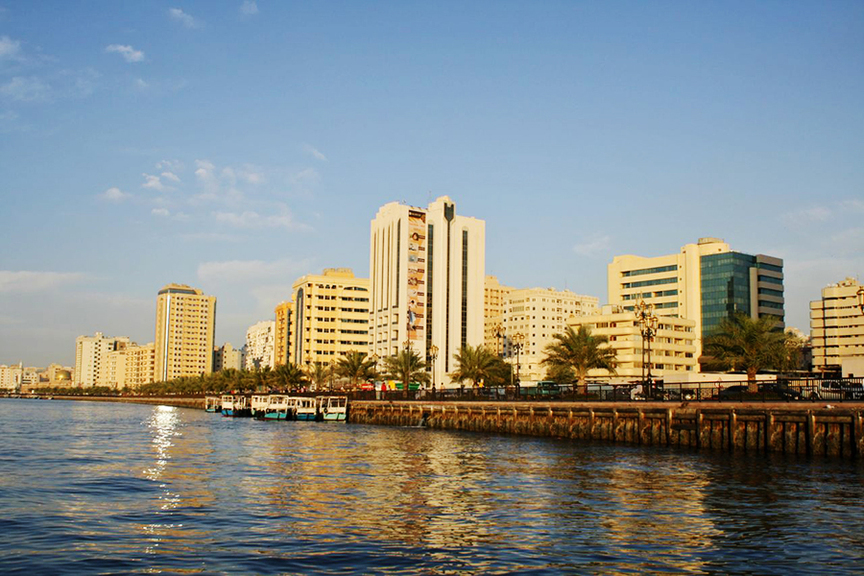Early evening on the waterfront along Sharjah’s Heritage and Arts area. Near the clustered boats was a barely discernible flag, by BYRON KIM, in a pitch-perfect imitation of Sharjah-sky blue, an extension of his interest in capturing atmospheric colour. Photo by HG Masters for ArtAsiaPacific.
The exhibition was opened after the arrival of Sharjah’s ruler Sheikh Sultan al-Qasimi (center right) and his daughter, Sheikha Hoor al-Qasimi (center left), who is president and director of the Sharjah Art Foundation. Photo by HG Masters for ArtAsiaPacific.
The coral-lined courtyards of Sharjah’s heritage district and the Sharjah Art Foundation (SAF) spaces, built around and between them, are some of the most distinctive spaces used by the biennial. Here, DAMIEN ORTEGA’s Talking Wall (2015) takes its cues from the district’s architecture, echoing the site’s porous constructions materials that facilitate ventilation. Photo by HG Masters for ArtAsiaPacific.
An assembled portion of DANH VO’s We the People (2010– ), a 250 piece-by-piece reproduction of the Statue of Liberty in copper repoussé—made in a Chinese factory. Here, 13 pieces form Lady Liberty’s left armpit, rising to the level of the structure around it. Photo by HG Masters for ArtAsiaPacific.
HAEGUE YANG’s An Opaque Wind (2015) drew on the history of Korean expatriates who, largely in the 1970s, were recruited to the Gulf in order to develop its oil industry. Her courtyard installation combined attributes of Sharjah’s traditional architecture, such as wind towers, with modern vents, shipping containers, and bricks and concrete blocks, and featured a small room with woven mats and Korean news program playing on a television. Photo by HG Masters for ArtAsiaPacific.
In Karesansui (2015), TARO SHINODA created a “dry landscape garden” in the Japanese tradition that he had studied. Using local rocks and sand, Shinoda added two small openings beneath the garden that slowly drained the sand, like an hourglass, creating the pair of holes seen here. Photo by HG Masters for ArtAsiaPacific.
CINTHIA MARCELLE also worked with the metaphor of shifting sands, using a process that from the construction industry for the production of plaster. She placed a roof of mesh-sifters above this courtyard, and throughout the exhibition, workers walking on the structure above sifted the sand into the courtyard, creating fine showers of sand and covering the tracks of previous visitors. Photo by HG Masters for ArtAsiaPacific.
Suspended from the ceiling of a SAF space was RAYYANE TABET’s dramatic Cyprus (2015), recalling a wooden boat that the artist’s father had purchased in order to transport the family from Lebanon to Cyprus 29 years earlier during the civil war. The journey was never fully attempted as Tabet’s father quickly realized it would be a doomed voyage. Photo by HG Masters for ArtAsiaPacific.
In one of the biennial’s compelling but unlikely pairings of artists, in the same building as Tabet’s ship were BYRON KIM’s “Sunday Paintings” of the past year. Kim has been making these works every Sunday since 2001 and he records not only the appearance of the sky but, in diaristic entries written on the surface, what has been happening in his and his family’s life at that moment. Photo by HG Masters for ArtAsiaPacific.
Another prominent aspect of the biennial was Joo’s decision to feature small monographic shows of experimental figures, including Etel Adnan, Lala Rukh, Chung Chang-sup, Saloua Raouda Choucair, and, as seen above, of FAHRELNISSA ZEID (1901–91), who was a member of an early avant-garde group in Istanbul and later in Paris. Photo by HG Masters for ArtAsiaPacific.
At the Sharjah Art Museum was a survey of SALOUA RAOUDA CHOUCAIR’s sculptures, whose forms echo calligraphy, lines of Islamic poetry and betrayed her abiding interest in geometry. Photo by HG Masters for ArtAsiaPacific.
Hanging from the side of Bait Obaid al-Shamsi were MARK BRADFORD’s recent series Untitled (Buoy) (2014), whose surfaces recall old seafaring maps and were hanging from colorful ropes. Photo by HG Masters for ArtAsiaPacific.
Further afield, in a Port Khalid warehouse slated for demolition was MICHAEL JOO’s Locale Inscribed (Walking in the desert with Eisa towards the sun looking down) (2014–15), in which he had painted the far wall in a reflective silver and excavated a deep ravine in front of it down to the port’s waterline. Throughout the space were grooves cut in the concrete floor that echoed falaj water channels. Photo by HG Masters for ArtAsiaPacific.
Near Joo’s installation in Port Khalid was ASUNCIÓN MOLINOS GORDO’s WAM (World Agriculture Museum) (2010/2015). Her installation fused the style of an old colonialist museum with the contemporary language of sustainable crop development. Photo by HG Masters for ArtAsiaPacific.
HASSAN KHAN was given the honor of being the first artist to work in SAF’s newest space, the so-called Flying Saucer building, designed by Sheikh Sultan al-Qasimi himself in the 1970s, and until recently a fried-chicken restaurant. Khan added brightly colored filters to the walls, and worked with Andeel, one of Egypt’s most prolific cartoonists on a series of billboards for the roof. His black-and-white film depicts an absurdist, existential comedy about two men arguing over a hand slapper and a cap of invisibility, in what read as a possibly a dark, political allegory. Photo by HG Masters for ArtAsiaPacific.




